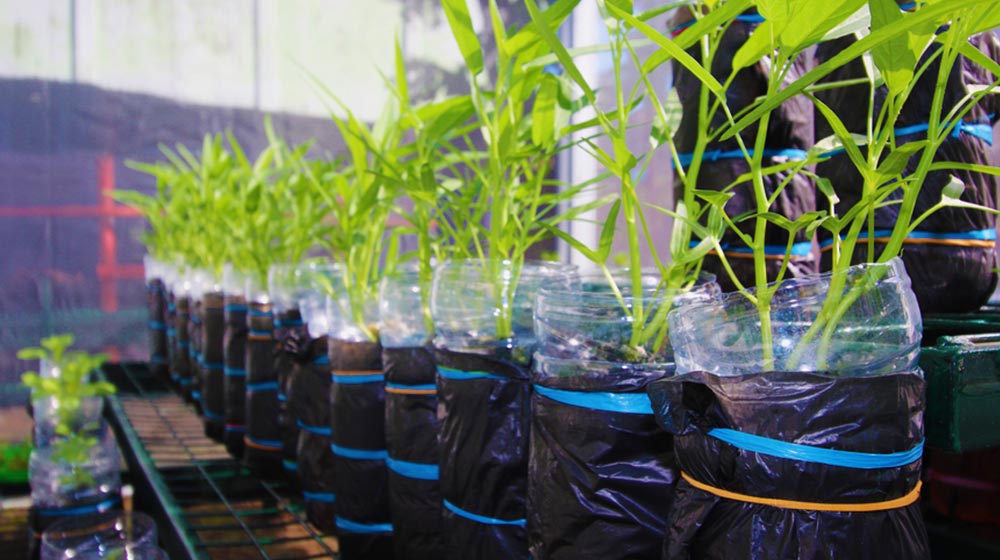A wick system is the easiest and the most basic among all hydroponic gardening methods. This is best for beginners and aspiring gardeners who want to try soilless gardening.
Today, I’ll show you how to build a wick system using materials you mlight already have at home!
RELATED: Hydroponic Gardening FAQs: What Is It And How Does It Work?
Wick System Hydroponic for a Soilless Gardening
What Is a Wick System Hydroponic
[instagram url=https://www.instagram.com/p/BtUXqCbn09W/ hidecaption=true width=800]
It is named the wick system hydroponic because the system uses wicks or cords so the water from a reservoir can convey upwards to the roots of the plants. This process is also known as capillary action.
A traditional wick system is passive which means it works even without pumps, motors, or any moving parts.
As mentioned, the system is suitable for city dwellers who would want to put up an urban garden and pursue their passion for gardening even with limited space.
Pros & Cons of a Wick System Hydroponic
The following are the advantages of a wick system:
- Easy to set up and maintain
- Simplest form among all hydroponic systems
- Requires minimal cost
- Uses less to no energy inputs
- Ideal for growing herbs and lettuce
While a wick system has its known advantages, it also has its drawbacks:
- Limited options for plants
- Slow supply of nutrients for bigger plants
- Prone to the build-up of toxic nutrients in growing medium
- Prone to the growth of algae and other microbes in the reservoir
- Not suitable for water-hungry plants like tomatoes, green cabbages, eggplants, peppers, and cauliflowers
Four Basic Components to Build a Wick System
A simple wick system is composed of four basic elements which include a growing container, a growing medium, a reservoir, and wicking materials.
For this particular DIY wick system, you’ll need:
- Plastic bottle
- Wick material (fiberglass cloth, nylon, or wool rope)
- Growing medium (Hydroton clay pellets or coconut noir)
- Water
- Plant Nutrients
- Black cloth or cardboard
Step 1: Make a Growing Container
A growing containers or a growing tray is where you’ll be growing your plant. This is placed at a slight distance above the reservoir.
Procedure
For a simple wick system, you can use a plastic bottle horizontally cut into two parts. The upper part of the bottle will be your growing tray. Don’t throw away the bottom part yet because you’ll be needing them later.
Step 2: Find the Right Wicking Materials
You can make wicks out of any absorbent material in your household like nylon rope, wool rope, felt, propylene strips, mop strings, and strips from old clothes.
While you can use just about any absorbent materials as your wicks, it’s still best to find and use the most durable wick that is rot resistant.
In most cases, the ideal wicking material you can find is fiberglass used for candle-making and oil lamps. You can buy fiberglass cloth in Amazon if it isn’t readily available in your household.
Procedure
Insert the wick through the rim of the plastic bottle and pull it upwards at approximately 2 inches. Leave the other side of the wick longer, depending on the size of the plastic bottle you are going to use.
The bottom part of the wick should be long enough to get drenched in the reservoir.
Make sure the overall length of the wick is just right to draw up the nutrient solution from the reservoir, straight to the growing medium, keeping it moist at all times.
Step 3: Install the Growing Medium
Since the movement of water in a wick system is slower than other active hydroponic systems, the growing medium must be very effective at absorbing water.
The most common growing medium used includes Hydroton clay pellets and coconut coir. The role of the growing medium is to act as the soil for the seeds to germinate.
Hydroton clay pellets, also known as LECA or light expanded clay aggregate, is one of the most versatile growing media in hydroponic gardening. You can buy 4 liters of Hydroton clay pebbles in Amazon for $16.95.
Procedure
Rinse the clay pebbles beforehand to wash off excess debris, then fill them in the growing container. You can transplant a seedling or you can also directly put the seeds over the growing medium.
Remember to flush and clean your growing medium with water every few weeks to get rid of any excess nutrients.
RELATED: Hydroponic Gardening: How to Get Started
Step 4: Put the System in the Reservoir
For the reservoir, you can use the other half of the plastic bottle you used for your growing tray. Add just the right amount of water nutrient solution, enough to soak the entire wick and the bottom part of your growing container.
The closer the reservoir to the growing container and the growing medium, the easier it is for the wicks to draw the water up to the roots of the plant.
Just like the growing medium, you need to refill and maintain the reservoir regularly. Make sure the reservoir is light-free to avoid the growth of algae and other microorganisms.
Procedure
Place your wick system in a shaded area and add black cardboard or cloth around the reservoir to block the light. Algae absorb the nutrients meant for your plants which will affect their growth, so remember not to skip this step.
Expert Tip: If you want an advanced hydroponic garden, install an aeration system to ensure the water is oxygenated. You can use a regular aquarium pump or air stone to efficiently aerate the nutrient solution to the roots.
[amazon box=”B00MHQ0IHA, B002JRGOT8, B002TCC46U, B017H73708″ grid=”4″]
Watch this video from the Urban Gardener on how to build a 5 gallon bucket water wicking system:
There you have it! Now you can set up a simple wick system out of materials you already have at home. The main advantages of a wicking hydroponic system are that it’s uncomplicated and easy to manage.
You can easily build one by upcycling common household materials. Start building your DIY wick system and enjoy soilless gardening in the comfort of your home!
Have you tried using a wick system or any other types of hydroponic gardening? Let us know in the comments section below.
Up Next:
- What Is Aquaponic Gardening And How Does It Work?
- 13 Ways On How To Save On Water Bill | Smart Gardening Tips
- 7 Exciting Ways In Preserving Flowers For Winter Delight
Calling all green thumbs, Garden Season needs YOU! Click here if you want to contribute for us!
Want to stay up to date? Follow Garden Season on Facebook, Twitter, Instagram, and Pinterest.



